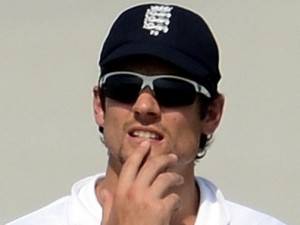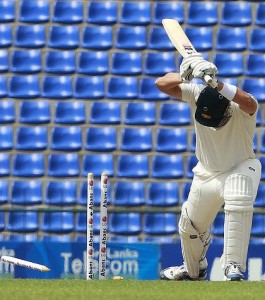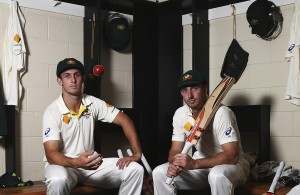
A gradual but inevitable descent into cricket-based loathing and bile.
The Devereux Diaries, Part Three: Divining The Aussie Batting Order
So far the Devereux Diaries have almost exclusively been dedicated to laughing at the ECB as they try to pull off the admittedly impressive trick of continuously shooting themselves in the foot whilst simultaneously sneering at the unwashed masses, otherwise known as ‘that lot who can’t afford to quaff Pinot Noir at Lords at 800 quid a bottle’. But it’s probably time to start looking at Australia, given that they have to play one of those Test series thingies soon. Against someone or other. The details have somewhat escaped us.
The Australian Test team is a topic worthy of further consideration to be honest. Most English pundits seem to have already handed them the Ashes, foreseeing a summer of torment at the hands of the two terrible Mitches in particular. But while this is most likely an accurate prediction of future events, it’s not entirely set in stone just yet. Australia, it must be remembered, aren’t really all that good at Test cricket. Pretty good, yes, but still not brilliant enough to be completely guaranteed of success. Like how a previous career ‘in the City’ doesn’t guarantee an employee isn’t also a complete and utter moron.
The biggest weakness Australia face ahead of the Ashes is their batting. It’s basically the same problem it’s had for years now: it’s just not very reliable. When it does work, like in the third Test against South Africa last year, then everything else tends to go swimmingly, but when it doesn’t work they either need someone to pull them out of the fire (like Brad Haddin and Mitchell Johnson in the second Test against India last summer), or else they’ll just fail pathetically. With Steven Peter Devereux Smith now confirmed as the greatest Test batsman to ever walk God’s green earth (yes, even better than Rob Quiney), things are looking a little more solid, but there is still an inherent fragility there that a bold, aggressive captain could potentially exploit.

Yeah, um, ah, how about another man on the boundary?
During the last Ashes tour in 2013 Australia’s batting was obviously an utter mess, and pretty much every possible batting combination was given a go at one point or the other, with the only real surprise being that they didn’t give reversing the order a try. This time round things will be far, far, more predictable. But there is still a little potential uncertainty there. Warner and Rogers will open, obviously, and whilst the wolves will inevitably begin to circle if Rogers fails a few times in a row, given that this is his last tour, odds are the two won’t be separated.
Number three will probably be held by Shane Watson. As we get older and, presumably, more mature, we have rather come to terms with Watson’s existence. Which doesn’t mean we like him, and certainly don’t agree with his continued selection, we have just resignedly come to terms with it. Besides, he was in decent form in the IPL. For what it’s worth.

Obligatory Watson looking like an idiot picture.
Numbers four and five are more interesting. Seemingly Clarke will come back into the Test team at four, and Devereux will drop down to five. Whilst this might seem a fairly mundane point, we wouldn’t actually mind if they switched positions. It seems funny now to remember that Clarke’s position in the Australian batting order was once the most pressing question Australian cricket faced, or at least so it seemed at the time. It doesn’t really matter where Clarke bats anymore you feel, and with Devereux doing such a good job recently at four (with an average of a mere 80) they might be tempted to keep things as they are.
Number six, though, is where the real problems lie. Right now there are three potential choices: Mitchell Marsh, Shaun Marsh and Adam Voges. Of the three Mitchell looks the least suitable, but it depends if English curators set the same sort of pitches they did in 2013 (i.e. the sort of decks that make the Atacama Desert look verdant) and Lehmann feels they need extra bowling cover. Shaun Marsh is the incumbent, and we guess he’ll likely hold the spot in the West Indies, but the player we’d like to see given a run is Voges, who has been in brilliant form for twelve months now. Plus there is his bowling, which must at least be the equal of Mitchell Marsh’s, what with his Test bowling average of 164 and all.

We assume this photo was taken just before they got smashed on Swan Lager.
With Haddin at seven and then a tail of Johnson, Starc, Harris and Lyon, a middle order of Clarke, Devereux and Voges would likely be enough to cope with any top order emergencies, especially those that emerge as a consequence of Shane Watson’s giant front pad. The other possibility is that Australia will play two spinners, and it looks like they may go with this option in the West Indies. Assuming they don’t revert to the ploy of claiming Johnson is actually an all-rounder, that means only two front line quicks, and buggered if we know how that’ll look, given that whilst Johnson and Starc are the two obvious picks, its not exactly the most reliable new ball pairing.
In short, we really don’t know how things will eventually work out. Unlike the last Ashes tour though, most of Australia’s selection conundrums are the result of having too many good players to pick from, as opposed to not enough. Even Peter Siddle is making a strong claim of being picked as the third quick, and if Fawad Ahmed plays well in the West Indies, the pressure on Lyon, or even on Lehmann to pick both, will only increase.

No Comments
Post a Comment